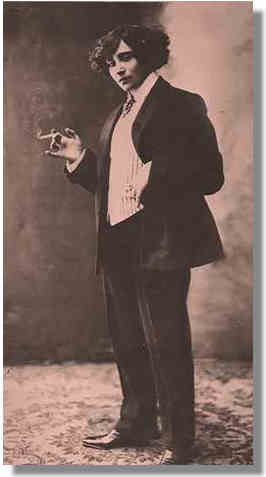
Sidonie-Gabrielle Collete was born in 1873 in Burgundy, France to her parents Sido (Adèle Eugénie Sidonie Landoy) and Jules-Joseph Colette. In her lifetime, Colette was a “mime-drama” actress (performing such places like the Moulin Rouge), a journalist, and a beautician (this profession was financially unsuccessful because she was constantly signing and discussing her books with whoever came to the shop).
However, she is renown for her some 50 major works of fiction, which include the Claudine series, Chéri, its sequel La Fin de Chéri, Dialogues de bêtes, and Gigi.
Her work is known for the use of nature, a love she had developed in her childhood. Another one of her loves were her numerous pets who were the characters of Dialogues de bêtes. Perhaps the best-known work of hers to Americans is Gigi and it’s Oscar-winning musical adaptation by the same title. Colette wrote this up lifting novel during World War II, a time when literature tended to reflect the war in form or another. Gigi has no reference what so ever to the war. A third interesting fact about her work is that many of them are autobiographical in one way or another. This is seen in the Claudine series (despite how her first husband twisted the truth to make the plots risqué), Sido (which is about the relationship with her mother) and a common theme is love rebuked (which can reflect here unsuccessful first two marriages).

Because of her success Colette gained high honors in the world of literature. In 1945 she was first woman admitted to the Académie Goncourt, four years later she was elected president of the Académie Goncourt, and a year before her death, she became Grand Officier de la Légion d’honneur.
Her last honor was given to her upon her death. In 1954, she became the first woman in France to be given a state funeral. However, much like when she was alive, her funeral caused controversy. Because she had been divorced twice and did not receive the last sacrament, the Cardinal-Archbishop of Paris decided that the church would not be involved with the funeral. Thus, when visiting Colette’s tomb in the Père-Lachaise Cemetery, you will not see a cross.
To learn more about this fascinating author here are my suggested readings:
Colette: A Taste for Life by Yvonne Mitchell. – This is a wonderfully detailed book about Colette’s life in its entirety.
Close to Colette: An Intimate Portrait of a Woman of Genius by Maurice Goudeket. – Her third husband, who was one husband that loved her for who she was and never tried to exploit her, wrote this lovely biography.
Blue Lantern by Colette. – This was the last book that she wrote before she was too weak to write. This is basically an autobiography. The title refers to the blue lamp that was mounted to the wall above her divan-bed (affectionately called the “raft”.)
Gigi by Colette. – This story is lovely about a girl growing up and falling in love. This heartening story is unique in the fact that it ends well.
Barks and Purrs by Colette. – This is a wonderful English translation of her Dialogues de bêtes that is available via Project Gutenburg. This is a charming book that is filled with conversations between her pet dog and cat. Illustrations are included!

Personal Note: I highly recommend the biographical books above for one main reason. They give a less altered and harsh/critical point of view on her life. Several sites on the web have stated that she was lesbian, which may have been true because certain friendships with women; however, this has never been fully proven. The second claim accuses her of having an affair with her second husband’s seventeen-year-old son, which caused her second divorce. The latter accusation is false (according to a few sources). She divorced her second husband because, like her first husband, he had several affairs with other women. This widely used claim was actually developed by a man (who turned out to be a friend of her first husband Willy) who Colette refused to sleep with. Believe what you will.